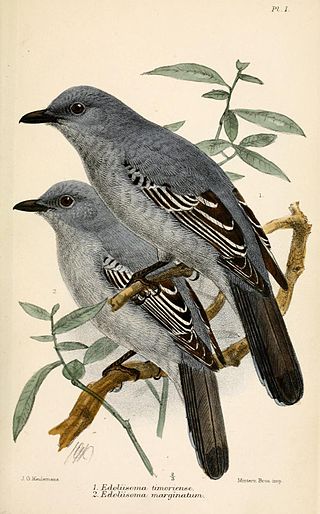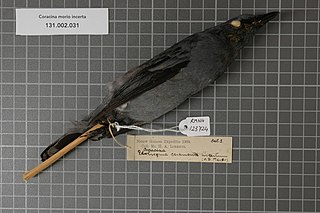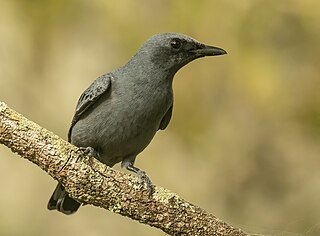
The New Caledonian cuckooshrike or New Caledonian cicadabird is a species of bird in the family Campephagidae. It is endemic to New Caledonia. Some taxonomists place this species in the genus Analisoma.

The pale cicadabird is a species of bird in the family Campephagidae. It is endemic to the Maluku Islands of Indonesia. Its natural habitats are subtropical or tropical moist lowland forest and subtropical or tropical moist montane forest.
The Kai cicadabird is a species of bird in the family Campephagidae. It is endemic to Indonesia.

The pale-shouldered cicadabird or Sumba cicadabird is a species of bird in the family Campephagidae. It is endemic to the Lesser Sunda Islands of Indonesia. Its natural habitats are subtropical or tropical moist lowland forest and subtropical or tropical moist montane forest.
The Solomons cicadabird, also known as Solomons cuckooshrike and black-bellied cicadabird, is a species of bird in the family Campephagidae. It is found in the north and central islands of the Solomon Islands archipelago. Its natural habitat is subtropical or tropical moist lowland forests. It is threatened by habitat loss. It was formerly considered to be conspecific with the Malaita cicadabird.

The black-shouldered cicadabird or Papuan cicadabird is a species of bird in the family Campephagidae. It is found in New Guinea. Its natural habitats are subtropical or tropical moist lowland forest and subtropical or tropical moist montane forest.

The black cicadabird, also known as the New Guinea cuckooshrike or New Guinea cicadabird, is a species of bird in the family Campephagidae. It is found in the Aru Islands and New Guinea. Its natural habitats are subtropical or tropical moist lowland forest and subtropical or tropical mangrove forest.

The black-bibbed cicadabird or black-bibbed cuckooshrike is a species of bird in the family Campephagidae. It is endemic to the Philippines. The species is elusive and poorly known. This species has five subspecies that differ considerably in plummage, it is possible that this may actually be a species complex and consists of multiple species.

The black-bellied cuckooshrike or black-bellied cicadabird is a species of bird in the family Campephagidae. It is found in New Guinea. Its natural habitats are subtropical or tropical moist lowland forest and subtropical or tropical moist montane forest.

The Sulawesi cicadabird is a species of bird in the family Campephagidae. It is endemic to Sulawesi in Indonesia. Its natural habitats are subtropical or tropical moist lowland forests and subtropical or tropical moist montane forests. The species is placed in the reinstated genus Edolisoma by some authors and the nominate subspecies E. morio morio was suggested to be part of the Edolisoma tenuirostre complex in a molecular phylogenetic study by Pedersen et al. (2018). The species was formerly considered to be conspecific with the Sangihe cicadabird.

The grey-headed cuckooshrike, also known as the grey-headed cicadabird or black-tipped cicadabird, is a species of bird in the family Campephagidae. It is found in New Guinea. Its natural habitats are subtropical or tropical moist lowland forest and subtropical or tropical mangrove forest.
The Sula cicadabird, also known as the Sula cuckooshrike or Moluccan graybird, is a species of bird in the family Campephagidae. It is endemic to Indonesia.

The Sahul cicadabird, previously known as the common cicadabird or slender-billed cicadabird, is a species of passerine bird in the family Campephagidae. It is found in Australia, New Guinea and the Bismarck Archipelago. Its natural habitats are temperate forest and subtropical or tropical moist lowland forest. The species is placed in the reinstated genus Edolisoma by most authors. The common cicadabird was described as a "great speciator" by Mayr & Diamond (2001); and Pedersen et al. (2018) described how this species rapidly colonized and diversified across the Indo-Pacific island region and Australia in the Pleistocene.

The Yap cicadabird, sometimes considered to be a distinctive subspecies of the common cicadabird, is a species of bird in the cuckooshrike family, Campephagidae.

The Pohnpei cicadabird is a species of bird in the family Campephagidae. It is endemic to the Caroline Islands. It was previously considered conspecific with the common cicadabird.
The Makira cicadabird is a species of bird in the family Campephagidae. It is endemic to the Solomon Islands. It used to be considered a subspecies of the common cicadabird.

Edolisoma is a genus of birds in the cuckooshrike family Campephagidae that are native to the Central Indo-Pacific region, Australia and New Guinea.

The Palau cicadabird is a species of bird in the family Campephagidae. It is endemic to Palau. It was previously considered conspecific with the common cicadabird. Its natural habitat is subtropical or tropical moist lowland forest.
The Obi cicadabird is a passerine bird in the family Campephagidae that is found the island of Obi in the Maluku Islands in Indonesia. The species was formerly considered to be conspecific with the common cicadabird, now renamed the Sahul cicadabird.
The north Moluccan cicadabird is a passerine bird in the family Campephagidae that is found on the Bacan Islands, the Tukangbesi Islands and the island of Morotai in the northern Moluccas Islands of Indonesia. The species was formerly considered to be conspecific with the common cicadabird, now renamed the Sahul cicadabird.














